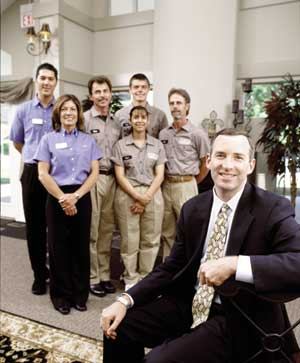Building a Backbone While Woodward saw operational challenges when he arrived, he also saw potential. “When I first came, my goal was to get Laramar behind the REITs [in terms of operations],” the CEO says. “I wanted to let them cut the path and we would follow behind.”
He has worked for this by taking a cumulative approach that relies on lots of little things adding up to increased revenue and efficiency. The backbone of the system consists of technology, people, and experimentation. For example, instead of settling for the conventional wisdom, Woodward wants his people to probe their markets and see what they can get as far as lease terms, rents, and concessions, within corporate reason.
Probing the market boosts revenue and value at Laramar. Jennifer Steans, president of Financial Investments Corp., an investor in about 80 Laramar deals, estimates that her firm received a 25 percent return on 40 deals that Laramar sold. “You see their management operations translate very clearly to the bottom line,” she says. Woodward estimates the combination of flexibility within a framework brings the company 3 to 5 percent more revenue than it might earn otherwise.
Word is starting to get out. After hearing about Laramar from a former company employee, Maria Hauser of Heathrow, Fla.-based Florida Capital checked out Laramar properties for herself, visiting several. The vice president of multifamily assets left impressed. “They have every system in place that you need,” says Hauser, who now is ready to assign approximately 1,000 units to Laramar for management.
The key to this program: revenue management. Instead of having his property managers raise rents at prescribed times (such as once a year), Woodward wants them to let the laws of supply and demand dictate pricing decisions. If all but two one-bedroom units in a property are full and the leasing office has a weekend with lots of prospective renters, the office has the leeway to raise rents by $25 a month on those units. If the price boost takes, Laramar just gained $50 in revenue a month for the next year. “Revenue management is all about testing,” Woodward says. “We tell people that it’s fine to raise prices $20. If it doesn’t stick, pull it back on Monday.”
The system also controls concessions. Instead of concessions of one or two months’ rent, Woodward likes dollar amounts. For instance, a Laramar resident may get a $1,000 concession instead of one month of free rent. This makes concessions scalable, meaning a property manager can change a “$1,000 off” promotion to $750 and easily test the market. When concessions are valued in months, managers can only go from one month’s free rent to a half-month, which is less flexible.
Lease expirations also give property managers opportunity for creative thinking. Instead of automatically offering 12-month leases, Woodward wants his people to track when units are hitting the market. If too many apartments expire at one time, especially in slow months like December and January, he wants Laramar properties to offer different, sometimes unconventional lease terms (such as 10 or 14 months) to entice renters to take leases ending in slower months. “The concept is that you only want the number of leases that you can handle expiring on a given month,” he says.
Technology qualifies as another key element of Woodward’s system. To him, it’s a multifaceted tool that makes property managers more efficient and controls excess use of resources in all sorts of places.
Take trash. Instead of paying trucks to empty trash bins on a twice-weekly basis at the Fillmore Center Apartments in San Francisco, Woodward had software installed that alerts the trash company when a bin is full. This limits trash companies’ visits to only necessary trips. The software, which cost about $5,000, saves the company an estimated $10,000 annually, according to Woodward.
The company also uses technology to improve the efficiency and professionalism of its e-mail responses to leasing inquiries. “This was an internal idea,” Woodward says. “It’s streamlined so that we have a professionally written response without having to create a new letter each time we get an inquiry.” Now the computer system sends an automatically generated e-mail letter with property information and links back to each person who asks about a Laramar property through e-mail.
